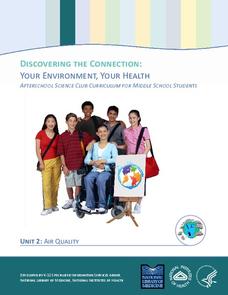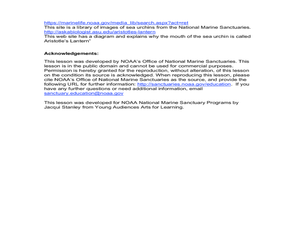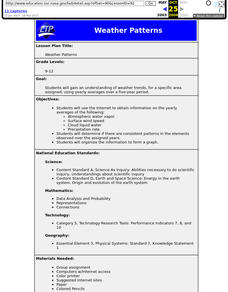National Library of Medicine
Your Environment, Your Health: Air Quality
Some scientists argue that air pollution now causes more deaths than smoking. The second unit in a six-part series focuses on air quality. Scholars learn what's in the air, how clean the air around their school is, and what they can do...
American Museum of Natural History
Talking to Fireflies
Fireflies are more than just mobile twinkle lights. An online interactive lesson teaches individuals about the light patterns fireflies use to communicate with each other. After they practice the patterns themselves, they could be...
Curated OER
Sampling Rocks
Here is a geology instructional activity which invites learners to explore a variety of rocks. They find rocks in the schoolyard and classify them according to size, color, and weight, then read the book Everybody Needs a Rock. Good...
Curated OER
Fabrics and Polymers
Learners explore natural resources by reading a science story in class. In this fibers lesson, students identify and discuss the differences between fibers such as wool, silk, rayon, linen and cotton. Learners identify the common uses of...
Curated OER
Star Gazers
Students research stars, constellations, planets and galaxies including names, shapes, sizes, colors, patterns and ages. They suspend the stars and planets from the ceiling and change monthy to display the various constellations. As a...
Curated OER
Look At Those Leaves!
Students explore botany by researching plants in class. In this tree identification lesson, students examine a group of leaves and list the different characteristics before guessing what types of trees they came from. Students read about...
Curated OER
Dinosaurs
Learners are introduced to the various types of dinosaurs and write in their journals about their favorite one. After listening to a story and watching a filmstrip, they color a few pages in their Dinosaur Friends Book. They also examine...
Curated OER
Weather Patterns
Second graders discuss how their weather changes by examining temperatures, clothing needs, and plant life. They talk about the identifying factors of the seasons and complete a Venn Diagram about weather in a guided lesson. Next, they...
Curated OER
Wacky Wildlife World
Fourth graders research organisms in the environment in Kentucky and create brochures for the local area wildlife reserves. Individuals create brochures that include information on habitat, body characteristics, scientific class, role...
Curated OER
Animal Habitats
Students explore animal lifestyles by researching their characteristics. In this animal habitat lesson, students read the story Over in the Jungle and analyze the animal illustrations in the book. Students create clay animal characters...
Curated OER
Sea Urchins - Diadema Antillarum
Pupils investigate oceanography by painting sea life. In this crustacean lesson, students identify sea urchins in our ocean environments and describe the functionality of their spherical-shaped bodies. Pupils design their own sea urchins...
California Polytechnic State University
Australian Geography Unit
At the heart of this resource is a beautifully detailed PowerPoint presentation (provided in PDF form) on the overall physical geography of Australia, basic facts about the country, Aboriginal history, and Australia culture and lifestyle.
Curated OER
Once in a Blue Moon
Third graders identify the phases of the moon. They use technology to access websites on the Internet dealing with the moon.
Curated OER
I Think I Forgot Something!
Students examine human health by reading a children's book in class. In this breakfast lesson, students identify the importance of starting the day with a good, nutritious meal. Students read the book I Think I Forgot Something and...
Curated OER
Changing Faces: A Study of Solar and Planetary Rotation Rates
Students determine rotation rates of a variety of solar system objects using images and the Internet.
Curated OER
Weather Patterns
Learners use yearly averages over a five-year period to understand weather trends for a specific area.















